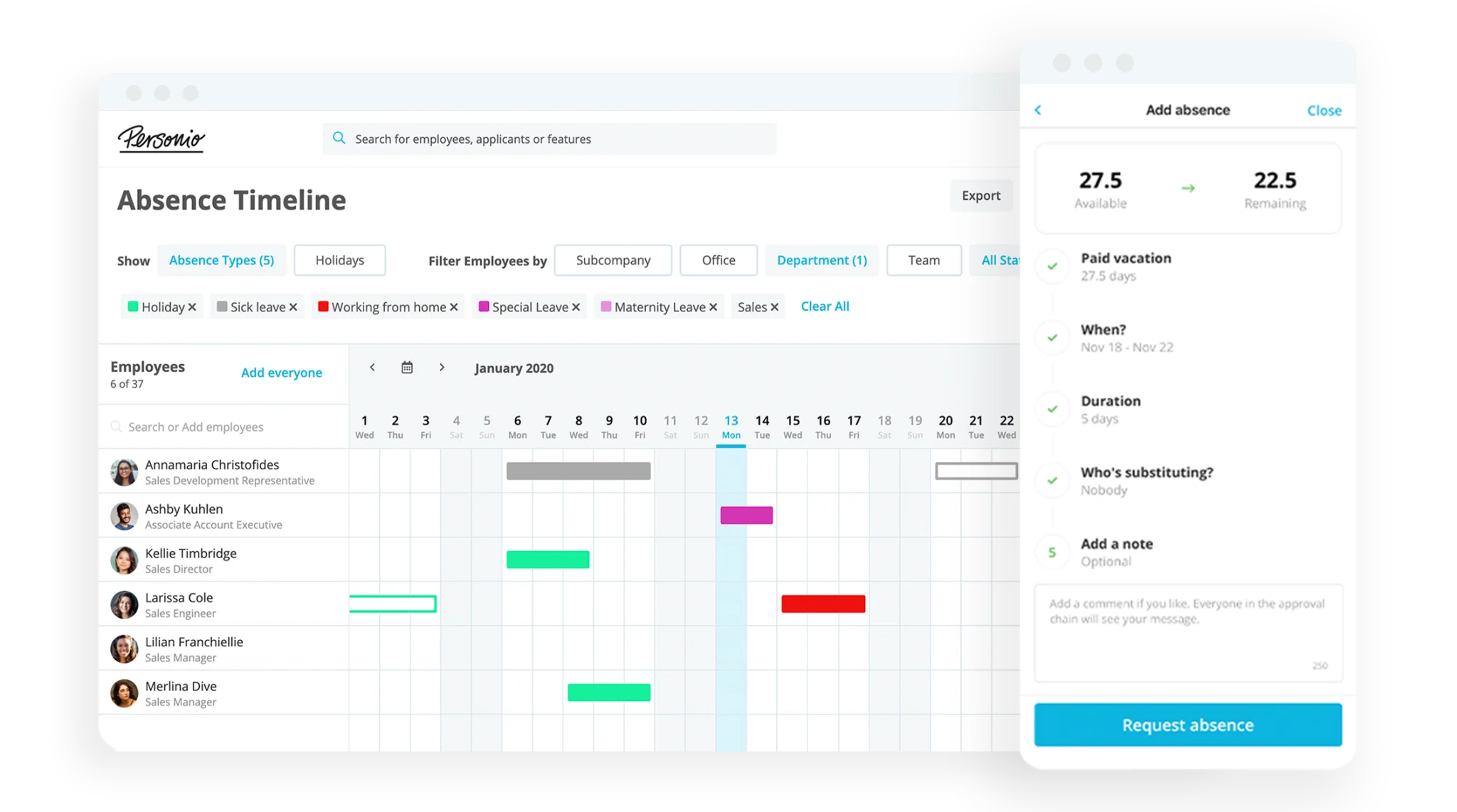When Should You Consider A Settlement Agreement?

Why would your organization ever need a settlement agreement? Well, no matter how positive your company culture or how strong your leadership team, conflicts and disputes are bound to arise in the workplace.
When matters escalate, though, proposing a settlement offer may be the best course of action for both the company and the individual worker. Here's our guide to this topic and what you can do about it today.
Managing both performance and documents is easier in Personio. Learn more today.What is a Settlement Agreement?
A settlement agreement, also known as a compromise agreement or termination agreement, is a legally binding contract used to mutually end an employment relationship or settle an employee dispute.
The contract outlines the terms of the agreement and stops employees from bringing claims against their employer, typically with the employee receiving financial compensation from their employer in return.
Settlement Agreement vs Redundancy: What’s the Difference?
Redundancy (whether compulsory or voluntary redundancy) is when an employer has to let an employee go from the company for a reason that is unrelated to their job performance or their behaviour at work, such as a recession, company closure, or the employee’s position being terminated.
Settlement agreements, on the other hand, are presented due to a very specific reason, which we will explore in the next section.
Click here to read our guide to redundancy pay and severance pay.
Why Might You Need a Settlement Agreement?
Even though settlement agreements are traditionally proposed at the end of an employee’s relationship with their employer — in an attempt to help the relationship end on good terms — they can also be used to settle disputes at any point in the relationship.
Some of the most common examples of settlement agreement scenarios include:
1. Unpaid Wages Disputes
A common reason why you may need to move forward with a settlement agreement is due to a dispute involving unpaid wages. For example, if an employee does not receive payment for overtime they’ve worked, a bonus they’ve earned, or even their standard paycheque.
In this case, the settlement agreement would focus on the employer paying out an agreed-upon sum of money to the employee. That said, this may not necessarily result in the employment relationship ending, although the relationship may worsen due to the experience.
2. Wrongful Dismissal Disputes
If an employee believes they were terminated without rightful cause, they or the employer can propose a settlement agreement.
Moving forward with a settlement agreement is likely the most appealing option for both parties. That’s because it would resolve the dispute quickly and for a lower cost than going through a tribunal or legal process.
3. Redundancy Appeal
If an employee’s position has been made redundant, their employer may present them with a settlement agreement. Again, this helps everyone avoid the lengthy process that is typically involved when dealing with redundancy procedures. Letting go of an employee due to redundancy can be quite difficult in its own right, as the employee hasn’t really done anything to earn a dismissal.
Click here to read our full guide to the redundancy consultation process.
To make up for this, employers will typically try to go the extra mile to make the process as smooth as possible for their employees by including a higher payment in their settlement agreement or providing services to help them find a new job.
4. Unfair Treatment, Misconduct, or Discrimination
When an employee experiences unfair treatment, misconduct, or discrimination from their manager, supervisor, or leadership team, they may propose legal action or request a tribunal.
A settlement agreement is often proposed instead to avoid litigation and instead reach a swift resolution of the issue. Although it’s not as common, companies and organizations can also offer settlement agreements to individuals who aren’t their employees. For example, if an applicant was interviewed for a position and believed they were turned down for a discriminatory reason and threatened legal action.
In this case, the employer may propose a settlement dispute to avoid the legal process and associated PR problems the dispute may cause.
5. To Avoid Damage to the Company’s Reputation
When an employer is faced with a dispute involving harassment, racism, discrimination, or misconduct, their reputation is on the line. Settlement agreements will often include a clause prohibiting the involved employee from discussing the matter publicly or slandering the company.
6. To End an Employee Relationship
When an employee has worked beyond their probation period but is no longer a good fit for the company due to lack of skill, interoffice relationship issues, or personality fit, a settlement agreement is often used to end the working relationship cleanly and avoid a wrongful dismissal suit. Although this is a difficult situation to navigate, the employer can include a letter of recommendation as part of the settlement agreement to improve the situation and help the employee find a better fit.
7. When Other Dispute Resolution Approaches Have Failed
Settlement agreements should not be the first choice when trying to resolve a workplace dispute. Rather, the company’s HR and legal team should first try to resolve the issue through mediation, discussion, and disciplinary action, only using a settlement agreement once those approaches have failed.
How Do You Propose a Settlement Offer?
Settlement offers can either be proposed verbally or in writing. The most appropriate course of action to take depends on the contents of the settlement agreement. For example, if the agreement is for a dispute that could result in legal action, a written proposal is likely the best step to take, whereas a minor dispute may be handled verbally.
No matter the dispute, both parties must thoroughly understand why the offer is being presented and must be clear on the accepted proposal.
Who Can Propose a Settlement Agreement?
While settlement agreements are usually proposed by the employer, an employee can also propose a settlement agreement to their employer.
Settlement agreements are voluntary and are typically reached after a negotiation process wherein all other dispute resolution options have been tried.
They are also used as a way to avoid a tribunal, but should not be used excessively or without going through due process beforehand.
Does the Employee Have to Accept the Settlement Offer?
The employee doesn’t have to accept the settlement offer, but they could still lose their job without the benefits the settlement offer could bring them, and they might not get a better offer. The terms of the settlement agreement must eventually be agreed upon by both parties.
How to Design A Settlement Offer
All settlement agreements will differ depending on the employee, the situation, and the employer’s goals.
Does the employee want to receive financial compensation? Does the employer want to help them find their next job? Does the employee wish to stay or be reinstated in their role?
To design an effective settlement agreement, here are some common terms that you should include:
Term | Definition |
|---|---|
The Involved Parties | The names of the employee(s) and employer(s) who are entering into the agreement. |
Offer Acceptance Details | Give the employee adequate time to consider the offer (at least one week). Also provide them with clear instructions on how they can accept the offer and who they should contact if they have questions as they review the offer. |
Financial Compensation | The amount of money an employer offers in a settlement agreement depends on the employee’s contract (pay, notice, unspent annual leave, length of employment), the reason for the settlement, and the cost of resolving the issue if you were to not move forward with a settlement agreement. In the settlement agreement, outline the amounts being paid to the employee, how they are being paid out (salary vs lump-sum), the deadline for the payments to be received, and if and how they are subject to change. |
The Impact on Benefits and Insurance Coverage | For many employees, losing their job often also means losing their health coverage and insurance. If the worker’s initial employee agreement covered benefits or insurance, the company may look into a way to help the employee retain some of those benefits for longer to help improve the process and their experience. If not, part of the settlement agreement may include increased financial compensation to cover those losses. |
Financial Ties | Outline how the settlement agreement will impact any financial ties the employee has with the employer, for example, if they hold shares in the company or have an upcoming bonus. See how their termination dates will impact their income; does it impact their qualifications to cash in their shares or their eligibility for a bonus? |
Outplacement Services | Outplacement services are often included in settlement agreements to help the terminated employee find work. This may include career counseling services, coaching, interview preparation services, or help with their CV. It can also include an employee reference to help them find a job faster, decreasing the financial impact the employee will experience from losing their job. Though including outplacement services in a settlement agreement isn’t mandatory, it can increase the appeal to the employee and make it easier for them to accept. |
Return of Property | Especially if the employee is working from home, the settlement agreement should outline what property is currently in possession of the employee that must be returned to the employer. This includes keys to the office, work computers or phones and accessories, company credit cards, and confidential documents. |
Learn More About Personio Today
Ensure your important documents, like settlement agreements, are stored in an easy-to-access and GDPR-compliant fashion. Click here to learn more about how Personio helps.
Disclaimer
We would like to inform you that the contents of our website (including any legal contributions) are for non-binding informational purposes only and does not in any way constitute legal advice. The content of this information cannot and is not intended to replace individual and binding legal advice from e.g. a lawyer that addresses your specific situation. In this respect, all information provided is without guarantee of correctness, completeness and up-to-dateness.

